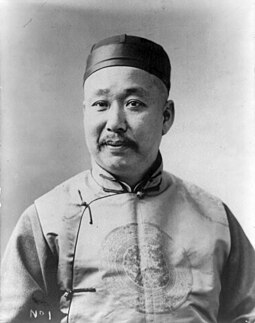Liang Cheng | |
|---|---|
 | |
| Chinese Ambassador to the United States | |
| In office July 19, 1902 – 1907 | |
| Preceded by | Wu Tingfang |
| Succeeded by | Wu Tingfang |
| Personal details | |
| Born | November 30, 1864 Panyu, Guangdong, Qing China |
| Died | February 3, 1917 (aged 52) British Hong Kong |
| Education | Phillips Academy |
| Liang Cheng | |||||||||||||
|---|---|---|---|---|---|---|---|---|---|---|---|---|---|
| Traditional Chinese | 梁誠 | ||||||||||||
| Simplified Chinese | 梁诚 | ||||||||||||
| |||||||||||||
| Liang Chentung | |||||||||||||
| Traditional Chinese | 梁震東 | ||||||||||||
| Simplified Chinese | 梁震东 | ||||||||||||
| |||||||||||||
| Liang Pi Yuk | |||||||||||||
| Chinese | 梁丕旭 | ||||||||||||
| |||||||||||||
Liang Cheng KCMG KCVO (November 30, 1864 – February 3, 1917[1]), courtesy name Liang Chentung, also known as Liang Pi Yuk, and later as Chentung Liang Cheng, was a Chinese ambassador to the United States during the Qing dynasty. He was primarily responsible for negotiating the return payment by the US of its share of the Boxer Indemnity for the establishment of Tsinghua University and the Boxer Indemnity Scholarship Program.
- ^ "Liang Pe Yuk". CEM Connections. Retrieved November 22, 2015.